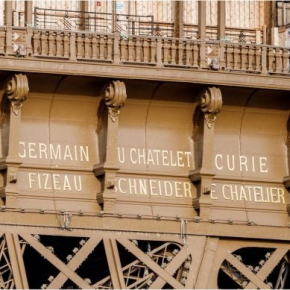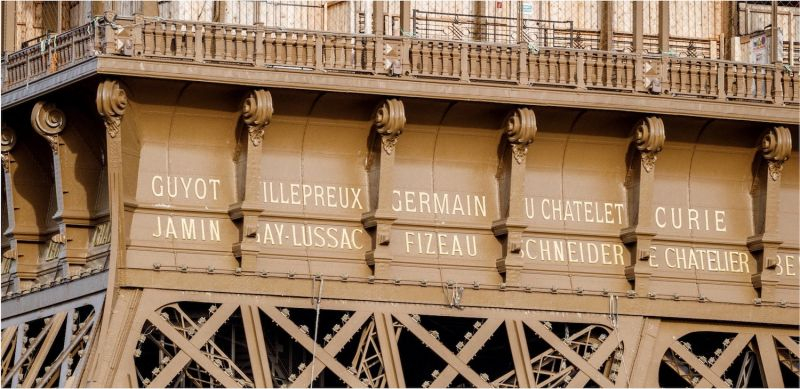Women scientists to be showcased on the Eiffel Tower soon
To rehabilitate the general view of women's contributions to the history of science, the CNRS is part of a commission that aims to inscribe the names of 72 female scientists on the Eiffel Tower. On September 5th 2025 a report giving details of this project was submitted to the Mayor of Paris. The co-chair of the CNRS's gender equality committee explains the initiative.
A report on the idea of inscribing the names of women scientists' on the Eiffel Tower has just been submitted to the Mayor of Paris. Could you tell us about this?
Béatrice Marticorena1 : This report results from several years of work. Benjamin Rigaud is a member of the 'Femmes & Sciences' association with which the CNRS has jointly organised several promotional initiatives on women in science starting with the 'La Science Taille XX Elles' exhibition. At the end of 2021 he launched the 'Les 40 Sœurs d'Hypatie' (The 40 Sisters of Hypatia) project, named after the mathematician, astronomer and philosopher from Alexandria, with Isabelle Vauglin, the association's vice-president, later taking responsibility for the project.
The idea derived from the observation that the Eiffel Tower – a symbol of scientific progress and advancement – has the names of 72 French scientists who lived between 1789 and 1889 inscribed in gold letters on its first floor. These names were chosen by Gustave Eiffel himself to pay tribute to previous generations of scientists and symbolise the hope scientific progress had inspired at the end of the 19th century. However, conversely the names chosen obscure the contributions made by women to the advancement of science, a phenomenon we now refer to as the 'Matilda effect'. The 'Les 40 sœurs d'Hypatie' project aimed to counter this negative effect by inscribing 40 names of women scientists on the second floor of the Eiffel Tower, opposite the 72 male scientists' names on the first floor.
The Paris City Council, the Eiffel Tower's owner, was impressed by this project and commissioned the 'Société d'Exploitation de la Tour Eiffel' (Eiffel Tower Operating Company) and the 'Femmes & Sciences' association to set up and co-preside a commission to run a feasibility study on the idea. The commission was made up of leading cultural and institutional stakeholders like the city's architect of historic monuments, the curator and architect of 'Bâtiments de France' at the Drac (Regional Directorate of Cultural Affairs) and the City of Paris's director of cultural of Paris who worked alongside the association of Gustave Eiffel's descendants, historians of the Eiffel Tower, and three renowned researchers who are all linked to the CNRS. These are the physicist Jacqueline Bloch, CNRS silver medal winner in 2017, the astrophysicist Françoise Combes, CNRS gold medal winner in 2020 and the climatologist Valérie Masson-Delmotte, CNRS silver medal winner in 2019. I represented the CNRS as the co-chair of our gender equality committee.
What are the main recommendations of this report?
B. M.: The commission decided to expand the initial idea of the 'Femmes & Sciences' project to inscribe the names of 40 women on the Eiffel Tower's second floor. The report submitted to Paris City Hall recommended that 72 names of women scientists should in fact be inscribed on the first floor above the frieze of the 72 men using the same technical process and gold-painted letters as for the men's names so the aesthetic and heritage principle would be preserved.
'Femmes & Sciences' has been asked to compile that list of 72 women scientists and, although the list has yet to be finalised, the commission has adopted two principles in its work on its composition. The first was that only French women scientists or those with close links to France should be included, such as Marie Curie who was Polish by birth. The second was that, while the women should all now be deceased, they did not necessarily have to have been contemporaries of the male scientists chosen by Gustave Eiffel which means the list may include women from the 20th and 21st centuries.
- 1Research Director at the CNRS and Deputy Director of the Interuniversity Laboratory of Atmospheric Systems (CNRS / Paris-Cité University / Paris-Est Créteil-Val-de-Marne University).
What was the CNRS's role in this?
B. M.: As co-chair of the CNRS's gender equality committee, I supported this proposal which is perfectly in line with the CNRS's work on promoting the role of women in scientific research. I obtained approval of the idea that national research organisations should be consulted on the choice of the scientists and so the various research organisations in France will each be able to put forward a few names. The final list will be submitted by 'Femmes & Sciences' to the Mayor of Paris in mid-december 2025, after consultation with the Academy of Sciences and the Academy of Technologies.
What are the next steps?
B. M.: The Eiffel Tower is a listed historical monument so changing anything about it is no easy matter! Before the 72 women scientists can be officially inscribed on the first floor, we will need to wait several months while the legal and administrative procedures required to modify a historical monument in France are completed.
The addition of these names should be accompanied by a major cultural outreach project for the general public and schoolchildren which the CNRS could take part in to raise awareness among young people about the work and recognition of women in science and even to inspire them to choose careers in these fields.

